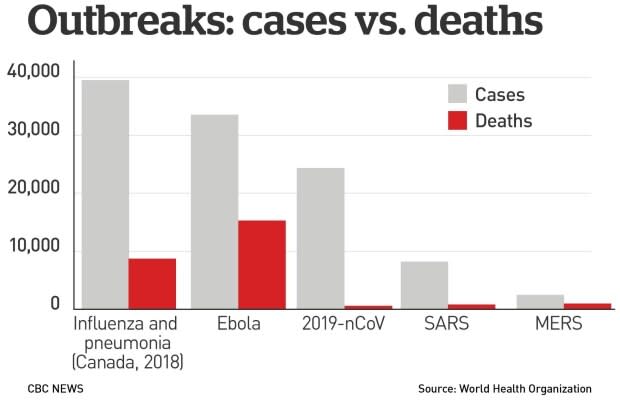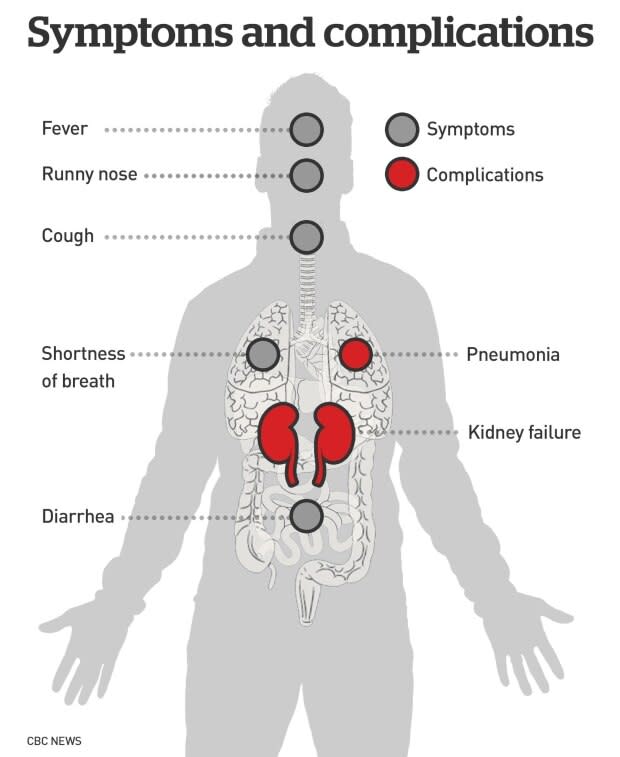By the numbers: Coronavirus outbreak charted

As cases of the coronavirus mount in China and elsewhere, health officials are focused on containing its spread.
The Chinese government is restricting people's movements as part of a "war of prevention of the epidemic," said President Xi Jinping. Controlling its spread in China helps protect people there and may buy time for health officials in other countries to prepare.
The Public Health Agency of Canada stresses that the risk of contracting the illness in this country remains very low. Travellers returning from the affected area are asked to watch for flu-like symptoms and to call ahead before seeking health care.
Officials from the U.S. Centers for Disease Control and Prevention said the goal of screening travellers from the epicentre of the outbreak near Wuhan, China, is to slow the entry of the virus into the U.S.
These graphics aim to put the outbreak into perspective.

As the death toll rises, the recovery total does, too. The vast majority of coronavirus cases have occurred near Wuhan and surrounding cities.

Less than 15 per cent of the lab-confirmed cases in China to date have caused severe health complications, like pneumonia, after infection.
Many have experienced symptoms similar to the flu and don't require emergency medical attention.
Globally, as of Wednesday, there are an additional 191 cases, including one death in the Philippines, not shown in the above image.
Ebola and influenza are not in the same family as SARS (Severe Acute Respiratory Syndrome), MERS (Middle East Respiratory Syndrome) or the 2019 coronavirus (2019-nCoV) — a temporary name for the new virus that was first detected in 2019. The other viruses are used here to put the severity of coronaviruses into perspective through comparison.

Lab-confirmed flu and pneumonia-related deaths in 2018 in Canada alone are higher than those of all three coronaviruses combined.
The lab-confirmed flu and pneumonia totals (shown above in grey) are not definitive. Many Canadians who become infected during any given year do not seek medical help, and therefore never get tested.
Coronaviruses are a large family of viruses that includes SARS, which affected 26 countries and resulted in more than 8,000 cases in 2003.
While the 2019 and SARS coronavirus seem to be closely related genetically, less is known about how transmissible and deadly the former is.

"In essence, it's a version of SARS that spreads more easily but causes less damage. The virus also uses the same receptor, the door used to get into human cells, which explains transmission and why it causes pneumonia. Most encouragingly though, this indicates that treatments and vaccines developed for SARS should work," for the new virus, Ian Jones, a professor of virology at the University of Reading, wrote in an online comment.
To estimate how bad an outbreak could get, experts look at the case fatality rate — the proportion of deaths a disease causes within a group of people.
The problem with estimating the case fatality rate early in an outbreak is that the sickest people tend to go to the hospital or a doctor's office. Those who don't show or have mild symptoms may never seek medical care and won't be counted as cases.

Information from the first 99 patients infected in China shows most had fever and cough. Less than a third had shortness of breath. Muscle aches, confusion, headache, sore throat, runny nose and diarrhea were less commonly reported.
Complications can include serious conditions such as pneumonia or kidney failure.

